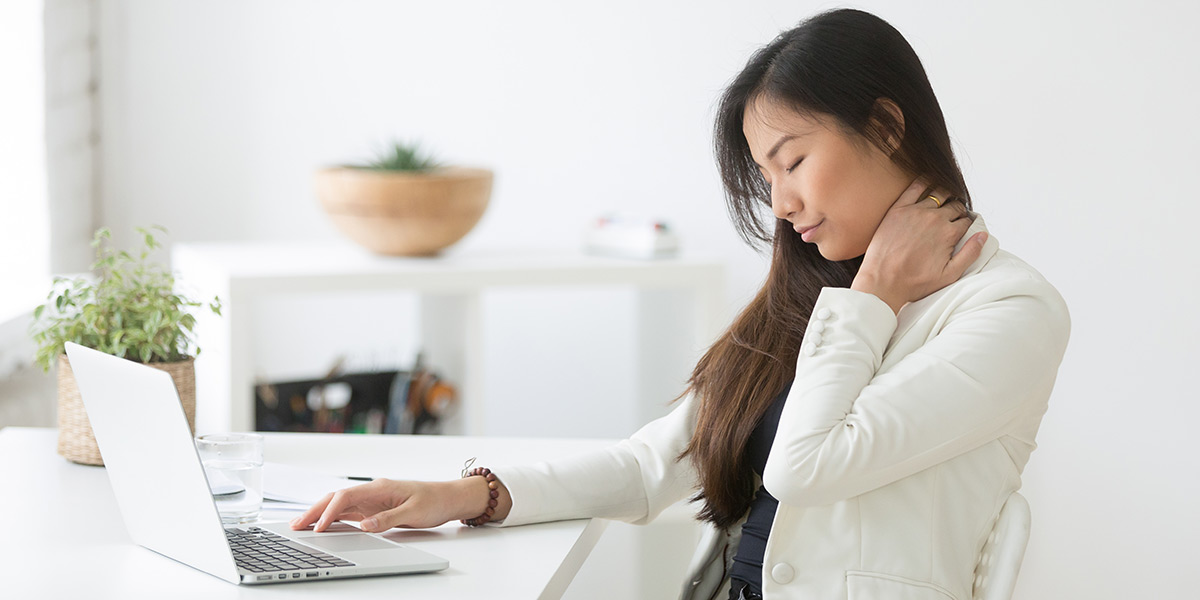Your neck does not have an easy job. It provides constant support to one of the heaviest parts of the body – your head! As we live and work, many of us experience neck pain from poor posture, muscle tension, worn joints, and nerve compression.
Read on to learn how neck pain can lead to headaches, and some easy neck stretching exercises you can do at home to release tension and find relief.
What Causes Headaches?
You may find it difficult to diagnose the exact cause of your headache. It could be anything from stress, to lack of sleep, to allergies. Oftentimes headaches are caused by neck pain. Issues with the ligaments, muscles, or vertebrae can put pressure on nerves in your cervical spine and base of your skull, leading to headaches.
Our necks are made up of 7 cervical vertebrae (C1-7), and the top three (C1-3) have nerves that travel to the head and send pain signals directly to the brain. The location and type of headache depends on which nerve is being strained in the cervical spine.
Even the most common everyday activities can cause strain in our cervical spine. Driving in the car, sitting at a desk, sleeping without a supportive pillow, and spending significant time looking down at our cellphones (“text neck”) can result in neck problems and chronic headaches.
How to Relieve Neck Pain
The first step to finding relief from neck pain is to notice your posture throughout the day and adjust accordingly. Do you notice strain in your neck or shoulders while doing any of the above activities? Try to realign your posture and keep your head directly above your neck throughout the day to reduce constant strain.
CEO Rylie Teeter shares her experience with headaches and how she’s learned to counteract symptoms and find relief.
5 Stretches for Neck Pain & Headache Relief
If you suspect that your neck pain is causing your headaches and you want to find relief, try following this step-by-step video tutorial by our Teeter Move Trainer, Max.
For these 5 simple stretches to relieve neck pain and headaches, Josh uses:
For easy reference, the instructions for each of the stretches are below:
Chin Glides
- Sit as straight and tall as possible on a bench or chair.
- Use your finger to guide the movement of your chin straight back. Try to draw your ears to your shoulders while maintaining a comfortable range of motion.
- Move the chin forward and back, keeping your mouth closed.
- Allow movement to flow smoothly. Do this back and forth motion for 30 seconds.
Trigger Point Massage
“Trigger points” are areas of strong tension in your body that feel tighter than other areas. Targeting and releasing these points is a great way to relieve pain and discomfort.
- Using the T3 massager, sit tall in your chair and apply gentle pressure with the pressure point knob on your trapezius, which is the muscle located between your neck and shoulder.
- Feel around and adjust to focus on any tender spots.
- Hold for 20 seconds or until you feel a release.
- Repeat on other side of neck.
Neck Restore
- Position the Neck Restore behind your neck, close to the base of your skull. This is called your occipital ridge.
- Let all neck and shoulder muscles relax over the Neck Restore.
- Find the perfect spot for release, comfortably extending your neck and letting the Neck Restore release tense muscles in your neck.
- You can try rotating your head to each side to release the side neck muscles, moving in a comfortable range of motion.
Foam Roller Breathing Exercise
- Place the foam roller on the ground and position the roller vertically underneath your back.
- Place your arms to the sides at 90 degrees.
- Inhale through the nose for 4 seconds, breathing into your belly.
- Exhale out the mouth for 4 seconds, emptying all the air from your lungs.
- Repeat this breathing exercise 10 x.
Inversion Table Neck Mobilization
- Invert on your Teeter Inversion Table at any angle that feels comfortable.
- Reach your arms overhead and pull your head gently from side to side, alternating every 10 seconds to elongate the muscles on the side of the neck.
- If you’re comfortable at full inversion, try hanging fully relaxed and use your hands to circle your head in one direction, then the other.
Get Real Back Pain Relief
Join over 3 million people who have found real back pain relief with Teeter.
